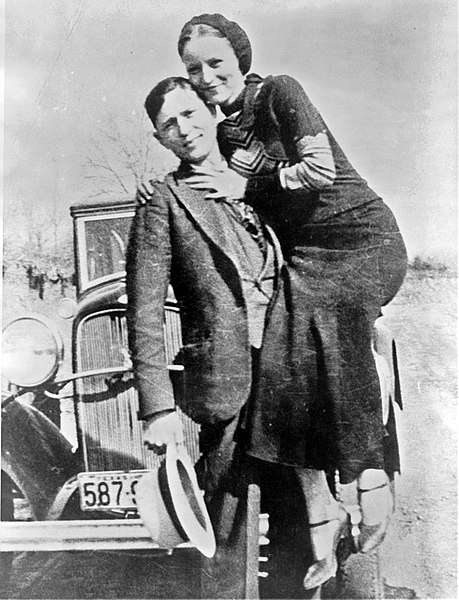 |
| Coulda been me - just that close |
But here's the thing - for all it's history, the BAR is inextricably tied up with one of the greatest and most notorious gunfighters in American history, Clyde Barrow. You can't paint Clyde with the same 'bloodthirsty thug' or 'mindless criminal' label that so many of his peers earned in spades. Where Dillinger wasn't a fighter at all, and Nelson and Floyd used brutality and savagery above weapons and tactics, Clyde Barrow was something apart. He fought to maintain his freedom, using his weapons almost exclusively against armed opponents. Now it's true that he was a "bad guy" and the lawmen he shot it out with time and time again were nominally the "good guys", but those distinctions could get a little fuzzy in the depression and dustbowl era Midwest.
The BAR was a unique kind of hybrid, a full power .30 caliber rifle that fired full automatic, or maybe a limited capacity machine gun that, instead of being belt fed, fired full power rounds from a 20 round magazine. However you looked at it philosophically, it was simply the most devastating weapon that could be fielded and operated by a single individual at the time. In combat it was impossible to counter, and in America, in battles with the law enforcement agents of the day, it was the closest thing you can imagine to a nuclear weapon. It gave Clyde Barrow an overwhelming firepower advantage no matter how many cops he was facing. And make no mistake, Clyde fought cops - he wasn't one to shoot civilians or seek bloodshed - but he wasn't going to be taken without a fight, and in those few months in '33 and '34, that became clear to all, even without Bonnie's poetry to drive it home.
The thing is, Clyde put more thought into his weapons and tactics than his peers did, and more than most of his opposition. The fad was the Tommy Gun, and sure, you could do worse, but Clyde knew something that other gangsters and many cops either didn't grasp or managed to overlook. The thing about killing is that it's not about guns, but rather about bullets. The legendary Thompson Submachine Gun, for all its cachet, fired a pistol round, the .45 ACP. And Clyde understood at his core that the only thing pistols were good for was fighting your way to your rifle. You might look cool with a Thompson, but you can shoot your way out of trouble with a BAR.
But Clyde didn't stop there. He created the 'Whippet Gun', so called because you could just "whip it out" when nobody knew you had it. He took a BAR, cut down the stock, sawed off the barrel to about sixteen inches, and screwed a leather sling to the back of the stock. The idea was you could hang it over your shoulder under a jacket, barrel down along your side. And at the first sign of trouble you could swing it up and send 20 rounds of 7.62×63mm full-power rounds downrange in about three seconds.
 |
| Clyde's Famous Whippet Gun |
There are lessons to be learned here, one large, and one small. The large lesson is that when they come to take your life, it is a fight, and you don't have to concede. You just don't have to quit fighting, ever, and sometimes things work out. The smaller lesson is that it pays to be practical, to think beyond the fads of the day, to work to understand what works and what doesn't, and just because the conventional wisdom is pointing one way, start at the other end, think about what it will take to accomplish your goals, and equip yourself accordingly.
...

I absolutely LOVE that top photo. A couple of 20-something kids in love with no path back. No way to turn off the craziness, no chance they can ever stop running, just living the moment and running forever. It actually would have been hard if they had lived a few more years, when the pace started to weigh on them. But a hard, fast twenty month suicide run, fighting and robbing and loving and laughing - ask yourself if your life is better than that.
ReplyDeleteI'm not sure mine is...
Oh, you old romantic you.
DeleteExcept that while on the run, they lived of life of misery and discomfort.
DeleteThis comment has been removed by the author.
ReplyDeleteinspriring
ReplyDelete